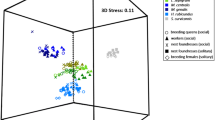Abstract
Both males and females of the primitively eusocial beeLasioglossum zephyrum can distinguish among female conspecifics with regard to genealogical relationship. Closely related females covary with respect to Dufour's gland pheromone products which are believed to function in individual or kin recognition. This is the first report of a population-wide parallel between similarity of communicative glandular product and genetic similarity.
Similar content being viewed by others
References
Barrows, E.M. 1975. Individually distinctive odors in an invertebrate.Behav. Biol. 15:57–64.
Barrows, E.M., Bell, W.J., andMichener, C.D. 1975. Individual odor differences and their social functions in insects.Proc. Natl. Acad. Sci. U.S.A. 71:2824–2828.
Bateson, P. 1983. Optimal outbreeding, pp. 257–278,in P. Bateson (ed.). Mate Choice. Cambridge University Press, Cambridge.
Batra, S.W.T. 1966, The life cycle and behavior of the primitively social beeLasioglossum zephyrum.Univ. Kans. Sci. Bull. 46:359–423.
Bell, W.J. 1974. Recognition of resident and nonresident individuals in intraspecific nest defense of a primitively eusocial halictine bee.J. Comp. Physiol. 93:195–202.
Bergström, G., andTengö, J. 1979. C24-, C22-, C20-, and C18-macrocyclic lactones in halictid bees.Acta Chem. Scand. Ser. B 29:390.
Buckle, G.R., andGreenberg, L. 1981. Nestmate recognition in sweat bees (Lasioglossum zephyrum): Does an individual recognize its own odour or only the odor of its nestmates?Anim. Behav. 29:802–809.
Cane, J.H. 1983. Chemical evolution and chemosystematics of the Dufour's gland secretions of the lactone-producing bees (Hymenoptera: Colletidae, Halictidae, and Oxaeidae).Evolution 37:657–674.
Cooley, W.W., andLohnes, P.R. 1971. Multivariate Data Analysis. Wiley, New York.
Crozier, R. H., andDix, W. M. 1979. Analysis of two genetic models for the innate components of colony odor in social Hymenoptera.Behav. Ecol. Sociobiol. 4:217–224.
Crozier, R.H., Smith, B.H., andCrozier, C. 1987. Relatedness within and between nests of the primitively eusocial beeLasioglossum zephyrum in Kansas.Evolution 41:902–910.
Dixon, W.J. 1981. BMDP Statistical Software. University of California Press, Los Angeles.
Duffield, R.M., Fernandes, A., Lamb, C., Wheeler, J.W., andEickwort, G.C. 1981. Macrocyclic lactones and isopentenyl esters in the Dufour's gland secretion of halictine bees (Hymenoptera: Halictidae).J. Chem. Ecol. 7:319–331.
Fletcher, D.J.C., andMichener, C.D. 1987. Kin Recognition. John Wiley, New York. Getz, W.M. 1981. Genetically based kin recognition systems.J. Theor. Biol. 92:209–226.
Getz, W.M. 1982. An analysis of learned kin recognition in Hymenoptera.J. Theor. Biol. 99:585–587.
Getz, W.M., andSmith, K.B. 1983. Genetic kin recognition: Honeybees discriminate between full and half sisters.Nature 302:147–148.
Getz, W.M., Bruckner, D., andParisian, T.R. 1981. Kin structure and the swarming behavior of the honeybeeApis mellifera.Behav. Ecol. Sociobiol. 10:265–270.
Greenberg, L. 1979. Genetic component of bee odor in kin recognition.Science 206:1095–1097.
Hamilton, W.D. 1964. The genetical evolution of social behavior. I, II.J. Theor. Biol. 7:1–52.
Hölldobler, B., andMichener, C.D. 1980. Mechanisms of identification and discrimination in social Hymenoptera, pp. 35–58,in H. Mark! (ed.). Evolution of Social Behavior: Hypotheses and Empirical Tests. Verlag Chemie, Weinheim.
Kukuk, P. 1985. Evidence for and antiaphrodisiac in the sweat beeLasioglossum (Dialictus) zephyrum.Science 227:656–657.
Kukuk, P., Breed, M.D., Sobti, A., andBell, W.J. 1977. The contributions of kinship and conditioning to nest recognition and colony recognition in a primitively social bee,Lasioglossum zephyrum.Behav. Ecol. Socibiol. 2:319–327.
Lacy, R.C., andSherman, P.W. 1983. Kin recognition by phenotype matching.Am. Nat. 121:489–512.
Maynard Smith, J. 1982. The evolution of social behavior—a classification of models, pp. 29–44,in Kings College Study Group (eds.). Current Problems in Sociobiology. Cambridge University Press, Cambridge.
Pamilo, P. 1984. Genotype correlation and regression in social groups: Multiple alleles, multiple loci and subdivided populations.Genetics 107:307–320.
Smith, B.H. 1983. Recognition of female kin by male bees through olfactory signals.Proc. Natl. Acad. Sci. U.S.A. 80:4551–4553.
Smith, B.H., Carlson, R., andFrazier, J. 1985. Identification and bioassay of macrocyclic lactone sex pheromone of the halictine beeLasioglossum zephyrum.J. Chem. Ecol. 11:1447–1456.
Author information
Authors and Affiliations
Rights and permissions
About this article
Cite this article
Smith, B.H., Wenzel, J.W. Pheromonal covariation and kinship in social beeLasioglossum zephyrum (Hymenoptera: Halictidae). J Chem Ecol 14, 87–94 (1988). https://doi.org/10.1007/BF01022533
Received:
Accepted:
Issue Date:
DOI: https://doi.org/10.1007/BF01022533




